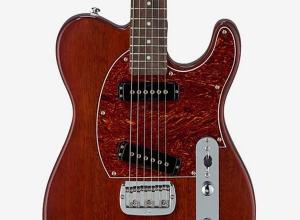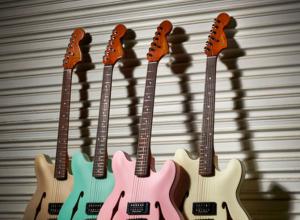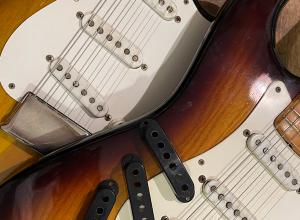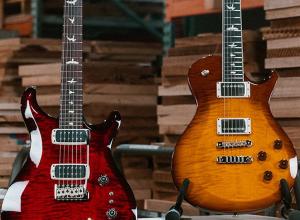Oggi confrontiamo due esemplari unici realizzati negli anni ’60 in California, nello stabilimento Mosrite di Bakersfield e nello stabilimento Fender di Fullerton.
Fin dal loro debutto sul mercato nel 1963, le chitarre Mosrite “The Ventures” hanno rappresentato qualcosa di assolutamente unico e rivoluzionario, e anche se la loro forma, ad un primo sguardo, poteva lontanamente ricordare quella di una “Stratocaster” più elaborata, il design, la componentistica e l’estetica erano qualcosa di mai visto prima su di una chitarra elettrica.
Ogni dettaglio infatti era stato accuratamente studiato e realizzato, a partire dal manico, progettato per risolvere molti dei problemi delle chitarre artigianali tradizionali, dai problemi di stabilità della paletta Les Paul ai problemi di intonazione dei manici Fender.
Ecco perché la nuovissima chitarra Mosrite offriva una eccellente suonabilità grazie ad un profilo sottile ed abbastanza veloce, ma con una piccola voluta sul retro della paletta per scongiurare le tipiche crepe ed un preciso design del capotasto “zero-fret” per una migliore intonazione.
L’hardware, dal ponte vibrato in stile Bigsby all’elettronica, veniva per lo più realizzato internamente da Mosrite. Il fondatore di Mosrite Semi Moseley, di Bakersfield, California, coltivò il suo innato talento come costruttore di chitarre studiando come apprendista prima presso la leggenda californiana Paul Bigsby, ma poi lavorò anche con Roger Rossmeisl alla Rickenbacker dove apprese le tecniche di intaglio e lavorazione “alla tedesca”, la ormai celebre “German Carve”.
I pickups, che potrebbero sembrare quelli di una Gibson P-90, in realtà sono realizzati in modo molto diverso, ed offrono un tono forte e definito allo stesso tempo.
È interessante notare che il pickup del manico è installato ad angolo per favorire un migliore bilanciamento sonoro, infatti le corde basse guadagnano più acuti ed i cantini più calore – l’esatto opposto della teoria alla base dei pickup Telecaster e Stratocaster di Fender.
Anche se Moseley divenne sponsor del famoso gruppo “The Ventures”, le loro chitarre signature non ebbero il successo sperato, e sfortunatamente l’azienda chiuse definitivamente nel 1969.
Oggi, qui a VintageVault, siamo veramente felici di condividere con voi questa chitarra molto rara e unica, una 1965 Mosrite “The Ventures” in finitura Sparkle Red.
Questo splendido esempio, realizzato a partire da Dicembre 1965 e completato nel 1966 è un pezzo molto interessante, e non solo per le condizioni sbalorditive, di fatto “pari al nuovo”, ma presenta una finitura di fabbrica insolita, in “Red Sparkle” assolutamente spettacolare.
Contrariamente a quanto si possa immaginare, queste finiture Sparkle non sono così spesse come ci si aspetterebbe, dato che sono ottenute mediante l’applicazione di diversi strati di vernice sovrapposti.
Dopo molti anni di dibattiti e ricerche, ora sappiamo che fabbriche come Mosrite o Fender hanno iniziato a spruzzare le proprie finiture “Sparkle” presso i loro stabilimenti a partire dal 1966, mentre negli anni precedenti, quando la musica “Surf” imperversava, si dovevano rivolgere ad artigiani specializzati, uno su tutti il famoso Dennis Swiden, per poter offrire queste finiture speciali.
Questo accadeva per una molteplicità di fattori, su tutti, le particelle metalliche della vernice sparkle richiedevano una pistola a spruzzo particolare, abbastanza grande da garantire una corretta spruzzatura delle stesse. Ma chiunque abbia mai provato a realizzare una finitura di questo tipo sa bene che il rischio di trovarsi con una miriade di puntini scintillanti in ogni angolo del laboratorio era reale, a meno di non avere una cabina di verniciatura dedicata appositamente per le finiture sparkle, cosa che, per come era organizzato il dipartimento di verniciatura della Fender a quel tempo, era assolutamente impossibile da gestire.
Per rendere meglio l’idea, anche un artista del calibro di Dick Dale, che era buon amico di Leo Fender e della fabbrica Fender, dovette portare la sua chitarra altrove per ricevere la finitura “Sparkle” ormai di moda e molto richiesta nei primi anni ’60, perché la Fender Factory non poteva realizzarla al suo interno.
È un dato di fatto, le finiture Sparkle pre-1966 sulle chitarre Fender possono essere suddivise in due categorie.
La prima di queste comprenderà quelle chitarre “assemblate in fabbrica”, a partire da un body nuovo di zecca inviato dalla factory all’esterno per la verniciatura custom, ma poi riassemblato come un modello “nuovo di zecca” dalla Fender.
La seconda comprende invece quelle chitarre “usate” o comunque ormai uscite dalla Factory e disponibili nei negozi dell’epoca, che sono state rifinite su richiesta del cliente in Sparkle, negli anni ’60.
Quindi, per essere in grado di determinare se una finitura Sparkle pre 1966 su una chitarra Fender è stata spruzzata su un corpo Fender nuovo di zecca, dovremo controllare tutti i dettagli dello strumento, dalle eventuali corrispondenze della vernice con le altre parti della chitarra, alle saldature (fondamentali in questo caso).
Ora torniamo a questa Mosrite e perché è così interessante.
La finitura Sparkle di questa chitarra è assolutamente identica a quella di una Fender Stratocaster del 1962 che abbiamo avuto la fortuna di scoprire qualche anno fa.
Le due finiture sono talmente simili da rendere plausibile pensare che Mosrite potesse offrire questo servizio di customizzazione anche per strumenti diversi da quelli presenti nel loro catalogo!
1962 Fender Stratocaster con finitura Sparkle Red – numero di serie 87178
Questa Stratocaster, numero di serie 87178, ha una particolare piastrina incisa, con le iniziali “J U N” in un elegante carattere, che sono state aggiunte quando la finitura personalizzata è stata richiesta dal proprietario originale.
Lo strumento è sicuramente un fantastico esempio dei giorni delle chitarre della “surf music”.
È stata realizzata sul finire del 1962 con la tipica tastiera spessa e “curva” ed ha un suono che ti lascia a bocca aperta, la chitarra dei sogni per ogni fan di Stevie Ray Vaughan.
Mentre la finitura è senza dubbio stata realizzata nella metà degli anni ’60, ci sono diversi indicatori che dicono che non è stata fatta su un corpo Fender nuovo di zecca né ordinata in fabbrica prima della produzione.
Tuttavia questa magnifica chitarra ha ancora i suoi tasti e tutte le parti originali, le uniche saldature mai ritoccate sono quelle sul potenziometro del volume, mentre tutte le connessioni tra il selettore CRL a 3 vie originale, potenziometri e pickup sono di fabbrica, e ogni parte è originale.
Nella tasca del manico è stata rimossa una parte della finitura che ha rivelato come il legno utilizzato per il body è un raro “swamp ash”, frassino leggero, utilizzato in genere per la finitura “Blonde”.
Uno strumento assolutamente unico e dal suono fantastico!
[EN] 1960s sparkle comparison: 1965 Mosrite The Ventures and 1962 Fender Stratocaster
Probably one of the most controversial subject among Collectors and Aficionados, “Sparkle” finishes always lit up the debate, wether they are “factory” or not, but one thing is for sure, they are a piece of art in their own, and absolutely beautiful to see in person. Today we compare two unique examples made in the 60s in California, at the Mosrite factory in Bakersfield and at the Fender factory in Fullerton.
Ever since their debut on the market in 1963, Mosrite “The Ventures” guitars were something absolutely unique and revolutionary, and even if their overall shape resembled something of a reversed Stratocaster form, nothing else looked like anything ever seen before on another Electric Guitar.
To start, the neck was designed to resolve many of the issues of traditionally crafted guitars, from the stability issues of the Les Paul headstock to the tuning issues of the Fenders, that is why the brand new Mosrite guitar managed to have a slim and quite fast profile, but with a small volute on the back of the head to prevent the typical cracks, and a precise zero-fret nut design for better intonation.
The hardware, with the Bigsby styled vibrato bridge to the electronics were mostly made in-house by Mosrite (Mosrite founder Semi Moseley, from Bakersfield, California, developed his talent as a guitar maker by studying with Californian Legend Paul Bigsby, but also learned the German-carve body style by working with Roger Rossmeisl at Rickenbacker). The pickups might look like a Gibson P-90s but in fact, they are quite differently made, delivering a strong, bold tone that can be fat and clear at the same time. Interestingly, the neck pickup is installed at an angle to help the bass strings gain more clarity and the treble strings more warmth – the exact opposite of the theory behind Fender’s Telecaster and Stratocaster bridge pickups.
Even if Moseley endorsed the famous group “The Ventures”, the expected success of their signature guitars never arrived, and unfortunately the Company closed for good in 1969.
Today we’re thrilled to share with you this very rare and unique guitar, a 1965 Fender Mosrite “The Ventures” in Sparkle Red finish
This gorgeous example from late 1965 is a very interesting piece, and not only for the jaw dropping “as new” conditions, but it features a very unusual factory finish, in lustruous and spectacular “Red Sparkle”.
Contrary to the common knowledge, these factory sprayed, “in house” Sparkle finishes are not as thick ad you’d expect, given that they’re the result of a several coats application process.
After many years of debate and research, we now know that factories like Mosrite or Fender started spraying their own “Sparkle” finishes sometime after mid 1966, while before that date they had to outsource the special color service. This happened because the spray gun for the special sparkles painting mixes needed to be large enought to ensure proper spraying of the metallic particles that embellissh the finish itself.
For reference, even Artists as Dick Dale, who was good friend with Leo and the Fender factory, had to bring their guitars elsewhere to receive the fashionable “Sparkle” finish in the early 60s, because the Fender Factory couldn’t offer it in-house.
As a matter of fact, pre-1966 Sparkle finishes on Fender guitars can be divided into “Factory assembled” guitars, where Fender would send a brand new body to be finished and then they would re-assemble the finished guitar as a “brand new” model, or just guitars that have been refinished to the customer’s request, to Sparkle, back in the 60s. So, to be able to determine if a pre 1966 Sparkle finish on a Fender guitar has been sprayed on a brand new Fender body we will have to check the whole instrument details, from matching paint to the neck, neckplate and parts, to the (fundamentals in this case) solders joints.
Now back at this Mosrite and why it’s so interesting. The Sparkle finish on this guitar is absolutely identical to a 1962 Fender Stratocaster we’ve handled a few years ago, to the point that it is not unlikely that the supplier for the “One off” finish could have been the Mosrite factory itself?!
1962 Fender Stratocaster in Sparkle Red finish – serial number 87178
This Stratocaster, serial number 87178, has a custom engraved neck plate, with the initials “J U N” in elegant font, that have been added when the Custom Finish has been requested by the original owner.
The instrument is for sure a fantastic example of the “Surf guitars” days.
It’s a late 1962 example with typical thick, “curved” fingerboard and has a sound that will blow your mind, to the likes of any Stevie Ray Vaughan fan.
While the finish is undoubtedly done in the mid 60s there are several indicators that say it was not done on a brand new Fender body nor factory ordered before production.
Nonetheless this magnificent guitar still has its original frets and parts, the only solders ever touched up are the lead and the ground of volume pot, while all the connections between the original 3 way CRL switch, pots and pickups are factory, and every part on this guitar is original.
In neck pocket some finish has been removed to show what was underneath and wood grain looks like Ash. So this is quite the looker and a fantastic sounding guitar. |
 VINTAGE VAULT
VINTAGE VAULT
 SHG MUSIC SHOW
SHG MUSIC SHOW
 PEOPLE
PEOPLE
 STORE
STORE
 - Privacy - Accordo.it Srl - P.IVA 04265970964
- Privacy - Accordo.it Srl - P.IVA 04265970964
![Confronto sparkle anni 60: 1965 Mosrite The Ventures e 1962 Fender Stratocaster [IT-EN] Confronto sparkle anni 60: 1965 Mosrite The Ventures e 1962 Fender Stratocaster [IT-EN]](https://www.accordo.it/cloud-assets/730x450/redazionea5/images/deco/105116_mosrite-g.jpg)




























